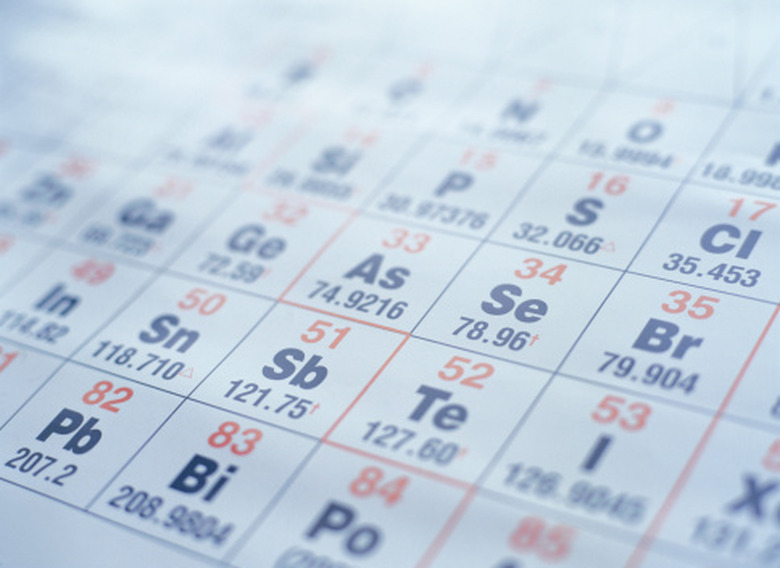How To Write The Shorthand Electron Configuration For Lead
Electron configurations tell you the occupied electron orbitals for any given element. This is important in physics and chemistry because the properties of the outer shell in particular determine how the element will behave. For lead, however, the configuration gets very long, because lead has 82 electrons, and so it would be time-consuming to write out in full. However, the "shorthand" electron configuration offers a shortcut that saves a lot of time and makes the configuration easier to read.
TL;DR (Too Long; Didn't Read)
The shorthand electron configuration for lead is:
[Xe] 6s2 4f14 5d10 6p2
Electron Configuration Basics
Electron Configuration Basics
Learn the basics of electron configurations before attempting to write out the configuration for any specific element. Electron configurations have three main parts: a number that tells you the energy level, a letter that tells you the specific orbital, and a superscript number that tells you the number of electrons in that specific orbital. An example electron configuration (for boron) looks like this: 1s2 2s2 2p1. This tells you that the first energy level (shown by 1) has one orbital (the s orbital) with two electrons in it, and the second energy level (shown by 2) has two orbitals (s and p), with two electrons in the s orbital and one in the p orbital.
The orbital letters you need to remember are s, p, d and f. These letters represent the angular momentum quantum number l, but all you need to remember is that the first energy level only has an s orbital, the second energy level has s and p, the third energy level has s, p and d, and the fourth energy level has s, p, d and f. Any higher energy levels have additional shells, but these just follow the same pattern and the letters from f onward just continue alphabetically. The order of filling can be challenging to remember, but you can easily look this up online. The order of filling starts like this:
1s, 2s, 2p, 3s, 3p, 4s, 3d, 4p, 5s, 4d, 5p, 6s, 4f, 5d, 6p, 7s, 5f, 6d, 7p, 8s
Finally, different orbitals can hold different numbers of electrons. The s orbital can hold two electrons, the p orbital can hold 6, the d orbital can hold 10, the f orbital can hold 14, and the g orbital can hold 18.
So using the rules, the electron configuration for yttrium (with 39 electrons) is:
1s2 2s2 2p6 3s2 3p6 4s2 3d10 4p6 5s2 4d1
Introducing Shorthand Notation
Introducing Shorthand Notation
Shorthand notation for electron configurations save you time in writing out the configurations for heavier elements. Shorthand notations make use of the fact that the noble gases have full outer electron shells, and some sources call it "noble gas notation" for this reason. Put the chemical symbol for the noble gas in front of the configuration in square brackets, and then write the configuration for any additional electrons in the standard way. Look at the periodic table and choose the noble gas (in the far right column) that comes before the element you're interested in. Before yttrium, krypton has 36 electrons, so the configuration from the last section can be written as:
[Kr] 5s2 4d1
This tells you "the configuration of krypton plus 5s2 4d1."
Full Electron Configuration for Lead
Full Electron Configuration for Lead
Lead has an atomic number Z = 82, and so it has 82 electrons. Write out the full configuration for lead as follows:
1s2 2s2 2p6 3s2 3p6 4s2 3d10 4p6 5s2 4d10 5p6 6s2 4f14 5d10 6p2
Shorthand Configuration for Lead
Shorthand Configuration for Lead
The shorthand for lead makes use of the configuration of xenon, with Z = 54 and therefore 54 electrons. Using the shorthand notation gives:
[Xe] 6s2 4f14 5d10 6p2
This means "the configuration of xenon plus 6s2 4f14 5d10 6p2."
Cite This Article
MLA
Johnson, Lee. "How To Write The Shorthand Electron Configuration For Lead" sciencing.com, https://www.sciencing.com/write-shorthand-electron-configuration-lead-8523324/. 3 May 2018.
APA
Johnson, Lee. (2018, May 3). How To Write The Shorthand Electron Configuration For Lead. sciencing.com. Retrieved from https://www.sciencing.com/write-shorthand-electron-configuration-lead-8523324/
Chicago
Johnson, Lee. How To Write The Shorthand Electron Configuration For Lead last modified March 24, 2022. https://www.sciencing.com/write-shorthand-electron-configuration-lead-8523324/
